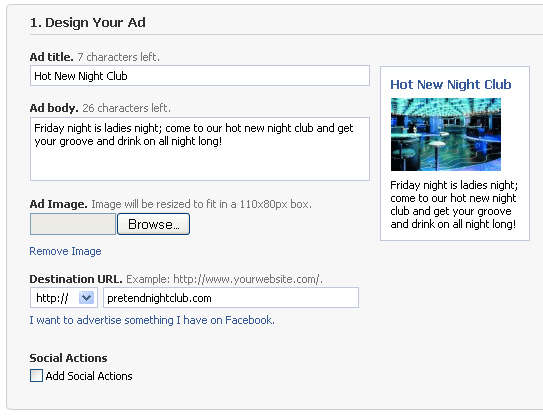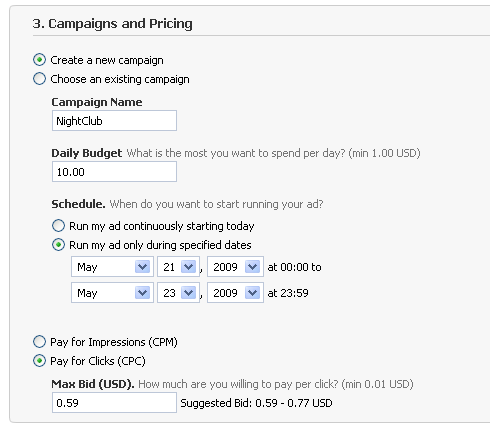Facebook Advertising Basics | Social Promotions

Let's move beyond traditional search engine marketing for a moment and focus on another very viable opportunity in Facebook advertising. It might be the largest social network site ever developed and is ripe with social marketing opportunities, but it also presents an amazing opportunity to advertise. Facebook is an impressive advertising platform that enables Web marketers/online advertisers to target by interest and demographics. Early adopters recognize it and are already leveraging the platform to drive high quality, inexpensive traffic.
The downside is that many advertisers have already caught on to the opportunity present. The result, as is the case with any advertising market, is that both the CPC (cost per click) and CPM (cost per thousand impressions) are increasing. There remain plenty of opportunities, however, in a variety of individual markets. One very pervasive problem that advertisers must accept (and that Facebook must acknowledge) is that users aren't actually looking for products or services when using the service. Instead, they are there to connect with one another and are often far outside of the buying or research mindset. That doesn't mean that we can't market to this group effectively.
Facebook advertising works (or can work) because of the rich data set the company has about users and groups of users. It is the job of advertisers to promote the right product, promote it to the right audience (gender, age, location, etc.) and use compelling ads to do so. But the requirements for advertisers don't stop there. As with any advertising, it is essential to test various ads (including images and text) and ad combinations. It is vital to understand what you are willing to pay. And most importantly, it is imperative that you have a clearly defined objective for ads and campaigns and create or modify landing pages to reflect that purpose. A failure at any point in this process will turn you off from any online advertising. Now that we have a solid understanding of the requirements, let's dig into actually using the Facebook advertising platform.
Say for instance we were promoting a new nightclub in Chicago.
Designing ads in Facebook is about as simple as it gets. Create a 25 character ad title and an ad body (135 characters), upload an image (optional but recommended) and provide a destination URL. Facebook does provide a few guidelines (e.g. not capitalizing every word, not using incorrect grammar and spelling, not including irrelevant or inappropriate images or using deceptive discounts and offers, etc.) that might act a deterrent for a few rogue marketers, but all ads are reviewed to ensure they meet Facebook's content guidelines (a test review took about 90 minutes but that was late at night). Advertisers are able to see the ad they create and make adjustments to text and images should it not appear as intended. While the system does not leave a lot of room for creativity, creating an ad for the most part is a simple and straightforward process.

The next step to getting started with Facebook advertising is the targeting - where the real value in the network resides. Since we're promoting our Pretend Nightclub in Chicago, we're able to narrow down our targeting to the specific location we want. Advertisers essentially start with a pool of 200 million users and refine their choices from there (Country, State/Province, City - and have the option to include cities within a specified distance using IP addresses of users). We'll use Chicago as the location for this particular ad. Facebook also lets advertisers indicate the age and gender of those who will see the ads. Since we're a) serving alcohol, 2) don't want anyone over 30, 3) want folks single and ready to mingle, 4) only want people who can spend some money, and 5) don't care whether those viewing the ad are male and female, we end up with a very respectable audience of 27,460 people. While that might not seem like the millions advertisers might anticipate, remember this is exactly the audience we're looking for. Not a bad start start considering our pretend club has a capacity of zero.

Establishing pricing for the Facebook ad campaign is where most advertisers should invest the most time and thought. New advertisers will first need to create a new campaign. Keep in mind that creating more than one ad in a campaign means you'll be sharing a daily budget and schedule. Advertisers have two options when it comes to the advertising model: either pay for impressions (CPM) or pay for clicks (CPC). Paying for impressions will be appropriate for advertisers interested in gaining brand recognition (when you just want people to see your ad), but since we actually want people to come through the ad to our landing page (where, for example, we might provide them a free drink ticket), CPC is a better option in this scenario. Facebook will ask the advertiser to provide a maximum CPC bid (how much they are willing to pay per click - minimum 0.01 USD) and provides some suggestions based on the targeting that was specified. Advertisers are able to lower the cost per click by removing some of the targeting, but doing so will result in less-targeted ads and even fewer targeted clicks. Since Facebook provides a range for advertisers to bid, play it conservative and place your CPC bid somewhere in the middle of the recommended bid. Our testing revealed that the CPC will gradually lower over the time the ad is running. Do keep in mind that the choice of CPC and CPM does influence the placement of ads; all Facebook ads compete with each other to show for each impression, regardless of how they are bid.

Facebook advertising works and a tremendous opportunity exists for those willing to invest. Have you tried Facebook advertising? Tell us about the results you received and what you might advise others considering Facebook as an advertising opportunity.

Subscribe to Our Newsletter!
Latest in Social Media









